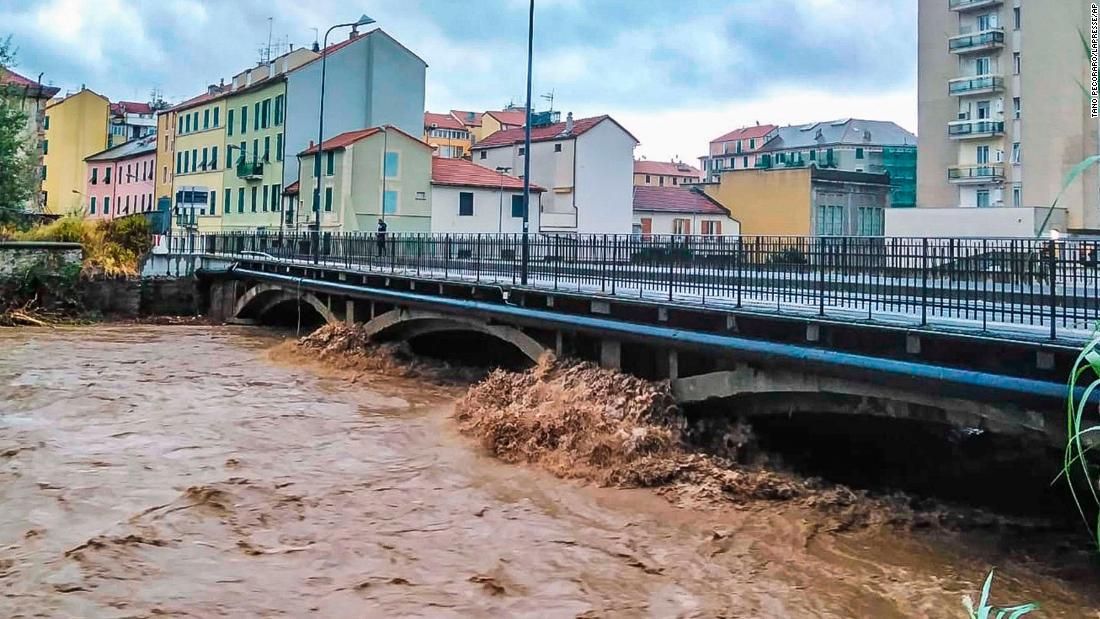On Monday, a series of storms put the brakes on parking in northwest Italy, triggering unprecedented rainfall rates across Europe after more than 29 inches (742mm) of rain in just 12 hours. In Oman, a rare tropical cyclone dumped years of rainfall, causing deadly flooding in the desert landscape that rarely sees much rain in an entire year.
The Italian province of Genoa, known for its natural beauty and rugged coastlines, has become the epicenter of the latest extreme rains.
A series of slow storms stopped in the area from Sunday to Monday, dumping more than 36 inches (925 mm) of rain in the town of Rossiglione, about 60 miles (100 km) southwest of Milan.
In some context, 36 inches is roughly equivalent to the average precipitation you can expect in Seattle in a year. It would take an average of 15 months for London to record such rainfall. Dozens of people had to be rescued after reports of mudslides and flooding dotted the landscape, causing a bridge to collapse in the town of Quiliano, according to Milan media outlet Corriere della Sera.
Wet weather is not uncommon in this part of Italy, as the region receives on average more than 1,200 mm (50 inches) of rain per year. However, the storm dropped nearly 30 inches (750 mm) in just 12 hours, establishing a new European mark for the
upper 12 hours of precipitation recorded, according to climatologist and specialist in extreme weather conditions Maximiliano Herrera.
In the nearby town of Cairo Montenotte, about 20 miles (32 km) west of Rossiglione, weather records continued to drop on Monday. A 6-hour deluge like never before in Italy brought almost 500mm of precipitation, breaking the national record of 6 hours for all of Italy,
Herrera noted.
A few miles to the east, mind-blowing rainfall also flooded the nearby town of Vicomorasso, after more than 180mm fell in just an hour, according to FloodList, an organization that documents extensive flooding around the world. .
By comparison, the remnants of Hurricane Ida flooded Central Park in early September after a 3.15-inch record fell in just 1 hour, breaking the previous one-hour record set just 11 days earlier when the tropical storm Henri flooded the area.
Rain in the desert
Less than 2 days earlier and just over 3,000 miles to the southeast, Cyclone Shaheen made landfall in far northern Oman with winds just below a Category 1 hurricane.
The storm inundated the normally parched town of Al Khaburah with more than 300mm of rain in a matter of hours, according to the Times of Oman.
That’s the equivalent of over 3 years of precipitation in about 24 hours. In neighboring Suwaiq, more than a year of rain has fallen
in just 6 hours. The storm produced a remarkable 4.57 inches (116 mm) of precipitation over a 6-hour period, exceeding what it typically sees in an entire year, according to Oman’s meteorological department.
Heated globe leaves room for more precipitation
The significant increase in heavy torrential rains observed around the world is becoming increasingly evident.
As global temperatures rise, extreme precipitation events will cause more water to fall, according to a report by the Intergovernmental Panel on Climate Change. The report pointed out that for every 1 degree Celsius (1.8 ° F) increase in air temperature, the atmosphere can hold about 7% more water vapor.
In the United States, the summer of 2021 was a case in point, as tropical systems such as Ida and Henri rewrote the record books multiple times in the space of a few weeks.
In August, Tennessee broke its previous state record after 17 inches of rain fell in the town of McEwen in just 24 hours. Just over a week later, the remnants of Hurricane Ida brought torrents of rain across the northeast, setting daily and historic records from New Jersey to New England.
These extreme precipitation rates are increasingly common due to man-made global warming, scientists say. According to the UN report on climate change, “the frequency and intensity of heavy rainfall events have increased since the 1950s over most of the land area”.
Deadly flash floods also made headlines around the world this summer, including deadly flooding in July across western Europe, after several months of rain that fell within hours, transforming the streets of cities across Belgium and of Germany in torrents of water.
Heavy rains also caused flooding in central China in July that killed more than 300. Zhengzhou, the provincial capital of 12 million people, has been one of the hardest-hit areas, with entire neighborhoods submerged and passengers trapped in flooded subway cars.
